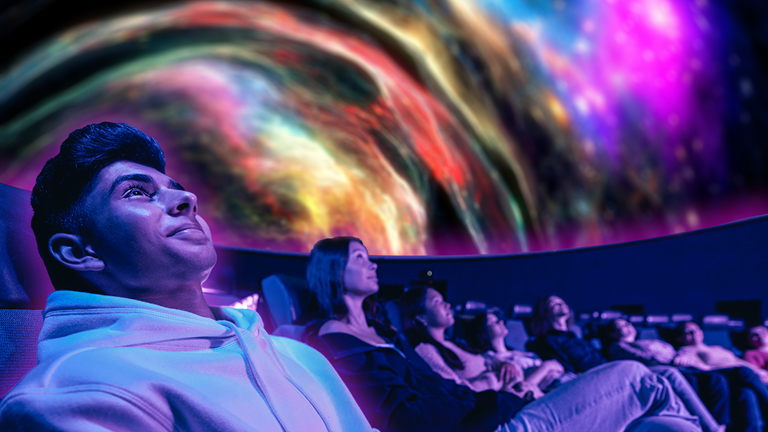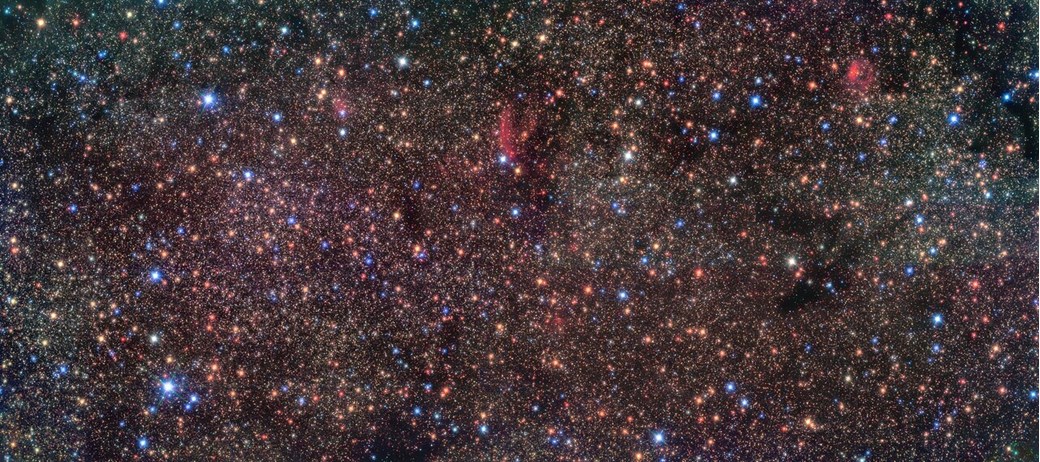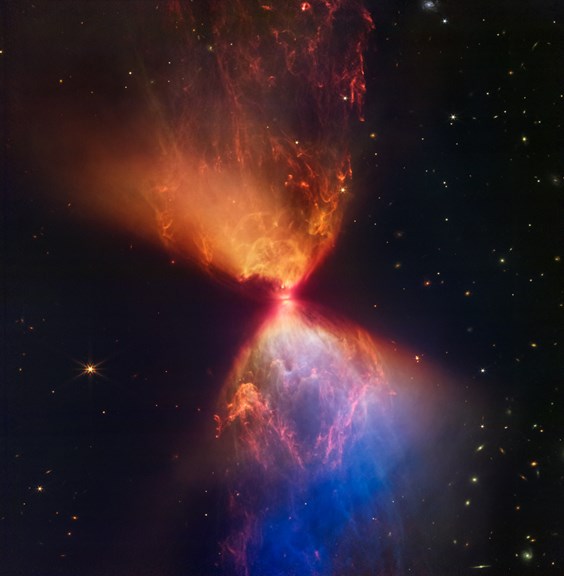Skynotes: January 2023
Upcoming events
Join us in the evening of Tuesday 14th February for an intimate night under the dome at the Melbourne Planetarium. Special programming to be announced. Check our website in the New Year for full details and to book.
Colourful stars in abundance
Released very recently is this rich infrared view in Sagittarius of the central region of our galaxy. It was taken by ESO’s Very Large Telescope (VLT) in Chile. While difficult to observe in optical wavelengths due to dust and gas which obscures much of the inner part of the galaxy, in infrared the dust and gas is more transparent and far greater detail can be seen of the star field.
This is part of the GALACTICNUCLEUS survey which aims to understand why, paradoxically, fewer stars than expected are found in this area of the galaxy.
The varied colours of stars are evident in this image. Hot blue stars, cooler yellow to orange stars, and red dwarfs which have the lowest surface temperature sit among a few especially dense and cold tendrils of interstellar material.
Explore more at:
Protostar and protoplanetary disc
Deep within the dark cloud or dust nebula L1527 in Taurus some 460 light years away, sits a protostar and associated protoplanetary, or circumstellar, disc of gas and dust. This extraordinary image was released last November from the JWST (James Webb Space Telescope) using its Near-Infrared Camera (NIRCam) and has been dubbed ‘the hourglass’ – two vast lobes connected by a narrow neck.
Only 100,000 years old this would-be star is not yet able to fuse hydrogen into helium – the power source for all stars - but draws matter in adding to its mass, density, pressure and temperature. In the centre of this image, seen edge-on is a small narrow dark band (the hourglass neck) that surrounds and obscures the protostar within. The band is an accretion disc where matter swirls around and feeds the growing object within. The disc is estimated to be the size of our solar system, and the protostar deep inside is 20-40% the mass of our sun.
The heat emitted by the protostar and its occasional bursts is carving out colourful regions (the hourglass lobes). From JWST’s viewing angle blue is where the dust is less dense while orange and red are where it is denser.
Over time as the protostar grows local clumping of material in the disc is expected to gradually form protoplanets. When it finally undergoes fusion and blows away the remaining disc material it may well leave behind newly formed planets in orbit around their parent star.
See:
Melbourne Sun times
| Date | Rise | Set | Day length | Solar noon§ |
|---|---|---|---|---|
| Sunday 1st | 6:01 | 8:45 | 14:44 hrs | 1:23 |
| Wednesday 11th | 6:10 | 8:45 | 14:34 hrs | 1:27 |
| Saturday 21st | 6:20 | 8:41 | 14:20 hrs | 1.31 |
| Tuesday 31st | 6:31 | 8:34 | 14:02 hrs | 1.33 |
§ When the sun is at its highest, crossing the meridian or local longitude.
Moon phases
| Date | Phase |
|---|---|
| Full Moon | Saturday 7th |
| Third Quarter | Sunday 15th |
| New Moon | Sunday 22nd |
| First Quarter | Sunday 29th |
Moon distances
Sunday 8th is lunar apogee (furthest from Earth) at 406,458 km.
Sunday 22nd is lunar perigee (nearest to Earth) at 356,567 km.
Planets
Mercury is very close to the sun this month and not easily visible although late in the month it can be seen from 4am before fading in the early dawn light.
Venus is a daytime object for the first half of the month, but afterwards it will be visible at 9pm low in the west before setting and hour later.
Earth will be at perihelion on January 5th. This is the closest point to the sun our planet reaches in its slightly elliptical orbit. It will be at 147 million km which, by contrast, is 5 million km closer than its aphelion or furthest distance of 152 million km which occurs in early July.
None of the planets orbits are circular and an elliptical orbit means that a planet moves fastest at perihelion and slowest at aphelion, as famously deduced for all known planets by Johannes Kepler and published in 1609 in his Astronomia Nova.
See:
Mars is moving towards opposition. It can be seen from around 9pm in the north-east, move across the north during the night with the Earth’s easterly rotation, and set by 2am in the north-west. It will be visible a little earlier each night during the month.
Jupiter is visible from around 9pm high in the north-west but will set by midnight. As the month progresses it will rise and set a little later each night.
Saturn can be seen early in the month in the west from 9.30pm before setting around 11pm, however by mid-month it will no longer be visible.
Meteors
While the Quadrantids in the Northern Hemisphere peak on the 4th in the Southern Hemisphere the Eta Carinids are active from 14th-27th although fainter with only a few per hour that peak on the 21st . Their radiant is located near the star Eta Carina not far from Southern Cross.
International Space Station
ISS orbits every 90 minutes at an average distance of 400 km appearing like a bright star moving slowly across the night sky. Here are some of the brightest passes expected this month over Melbourne and Central Victoria:
Evening
Sunday 1st 9:17pm-9:24pm West-South-West to North-East
Morning
Wednesday 25th 4:54am-4:59am West-North-West to South-East
Heavens Above gives predictions for visible passes of space stations and major satellites, live sky views and 3D visualisations. Be sure to first enter your location under ‘Configuration’.
Stars and constellations
Summer offers a range of objects to enjoy from north through east and to south including a major neighbouring galaxy, close and open star clusters, red giant stars, well known constellations large and small, and the brightest star at night, and not forgetting the vastness of the Milky Way’s band across the sky with its dense concentrations of distant stars and interstellar dust clouds.
In the south
The Southern Cross (Crux) and the nearby Pointers (Alpha and Beta Centauri) are easy to spot low to the horizon in early evening. Adjacent to the Southern Cross is the dark dust cloud known as the Coal Sack that forms a veil that blocks the light of more distant stars from reaching us. Enjoy this ESA page and ESA video
High in the south on their own are our two neighbouring small galaxies the Large Magellanic Cloud (LMC) and Small Magellanic Cloud (SMC) at 160,000 and 200,000 light years respectively. From the southern hemisphere they are a treat and always visible in our skies which is not the case for equivalent latitudes in the northern hemisphere.
A recent interpretation is that the two Clouds of Magellan appear not to be orbiting our galaxy as long assumed, but in fact may be making their first pass of the Milky Way after colliding with each other around 300 million years ago. The collision may have distorted them, depleting them of gas and stars, leaving them diminished in their current irregular form.
See more at:
In the east
The brightest star at night lies directly east - Sirius the principal star in the constellation of Canis Major (Greater Dog). It is 8.6 light years away and therefore a close neighbour to the sun but with twice the mass of our sun, greater size, surface temperature and luminosity.
In the north-east
The Saucepan asterism is easy to spot using the three bright stars as its base. They are the belt of Orion the hunter who is upside down in our southern perspective. Orion’s scabbard or sword sheath (the saucepan’s handle) contains a fuzzy object which is the beautiful Orion Nebula which is where new stars are developing from vast clouds of hydrogen and dust. Two very different stars are also part of Orion; top left is the hot blue giant Rigel as one of his feet, the other is the cooler red giant Betelguese at bottom right which is one of his shoulders.
In the north
An open cluster the Hyades some 150 light years away forms an inverted V which marks the head of Taurus the bull. At its lower right corner is Aldebaran another red giant which is much closer to us at 65 light years. To the left can be seen the more compact cluster of stars known as the Pleiades (or Seven Sisters). These hot blue stars are young, formed together and are only the brightest members of a much larger number of stars all bound together under their mutual gravity.
In the north-west
Well worth identifying is the small fuzzy patch low to the north-western horizon. That’s the most distant object you could ever see with your unaided eye. It’s the glorious spiral galaxy Andromeda M31 containing a trillion stars some 2.5 million years away. Andromeda, our Milky Way and the Triangulum Galaxy M33 are the three major galaxies in our corner of the universe and together with 80-100 smaller galaxies they form the Local Group – our cosmic neighbourhood.
See:
On this day
1st 1801, the first asteroid, Ceres, was discovered by Giuseppi Piazzi.
2nd 1959, first detection of solar wind by Luna 1 (USSR) as it passed the moon.
4th 1958, the first satellite, Sputnik (USSR), fell back into the atmosphere and disintegrated after 11 weeks in orbit.
4th 1959, first human-made object enters heliocentric orbit, Luna 1 (USSR).
4th 1643, birth of Isaac Newton famous for studies in optics, the reflecting telescope, laws of gravitation and motion, and co-creator of calculus.
5th 2005, discovery of the most massive and second largest dwarf planet, Eris at 2,300 km diameter, by team led by Mike Brown at Palomar Observatory.
7th 1610, Galileo Galilei’s discovery of Jupiter's four largest moons: Io, Europa, Callisto and Ganymede.
8th 1942, birth of Stephen Hawking, theoretical physicist, cosmologist and science celebrity.
11th 1787, discovery of Uranus’s first two moons, Titania and Oberon by William Herschel.
16th 1969, first docking in space and first crew exchange in space between Soyuz 4 and Soyuz 5 (USSR) in Earth orbit.
18th 1916, meteorite falls onto occupied house in Baxter, Missouri (USA).
19th 2006, New Horizons spacecraft (USA) launched to Pluto for its 2015 fly-by.
23rd 2003, final communication with Pioneer 10 (USA), first interplanetary probe to Jupiter, which later left the solar system.
25th 2006, first icy-rocky planet discovered orbiting a main sequence star, a red dwarf at 21,500 light years from Earth.
27th 1967, fire in Apollo 1 (USA) command module kills crew of three in ground test at Kennedy Space Centre.
28th 1986, space shuttle Challenger (USA), the 10th shuttle flight, explodes 73 seconds after lift-off killing all seven crew and halting the program for 32 months.
31st 1961, first hominid in space, chimpanzee Ham, in Mercury-Redstone 2 (USA), who survived and lived in zoos until 1983.
31st 1958, discovery by James Van Allen of radiation belts of charged particles from the Sun that surround Earth and which now bear his name.
31st 1958, Explorer 1 the first successful American satellite launch, and first satellite to carry instruments into space.


